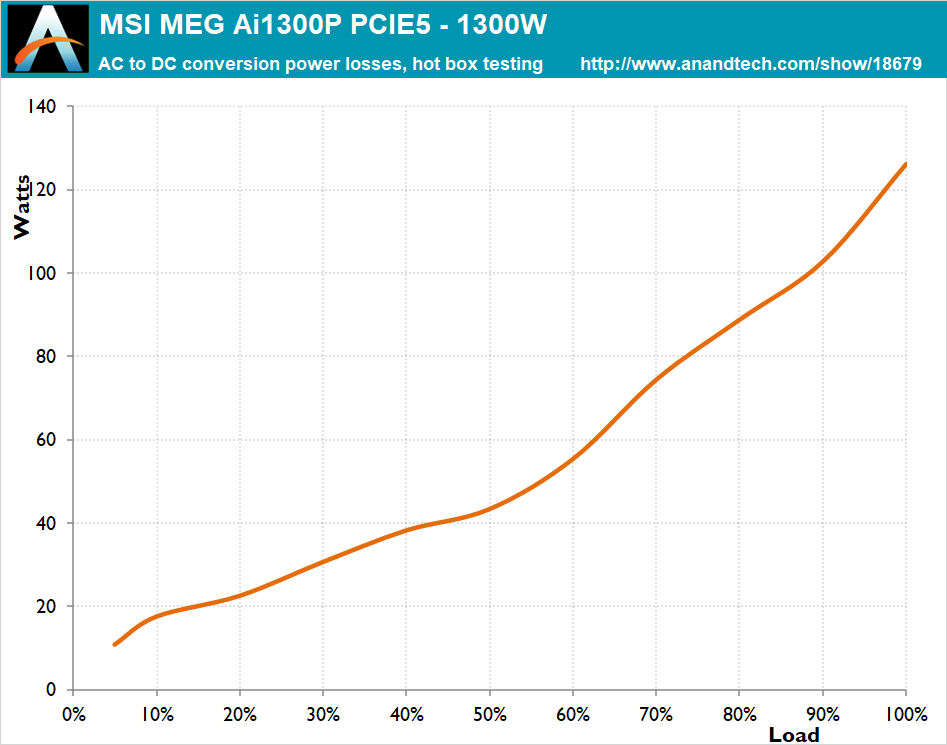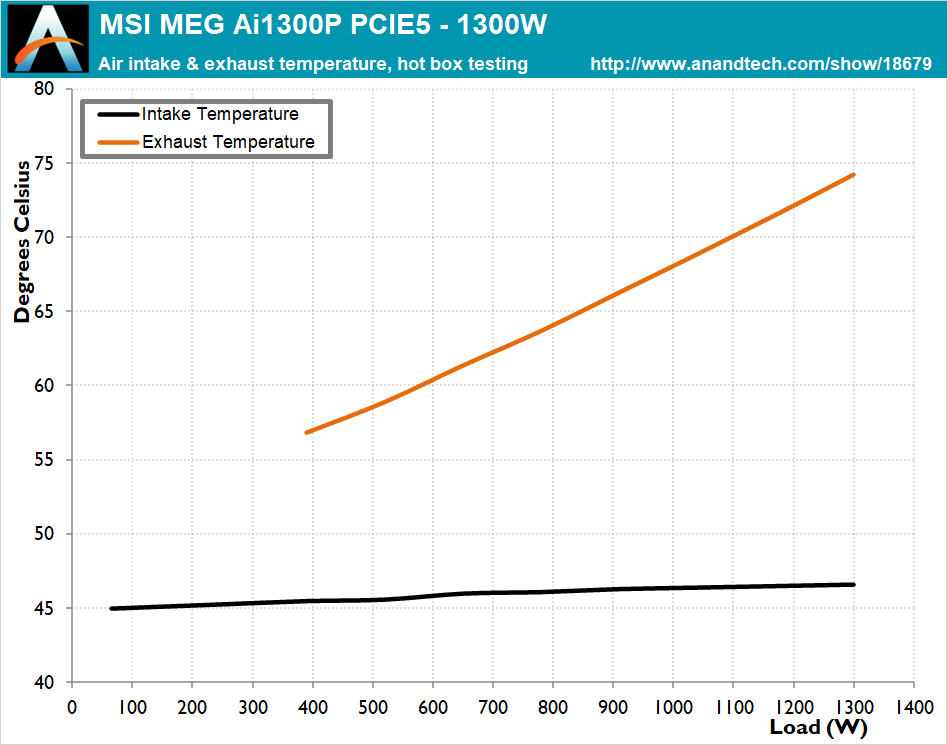The MSI MEG Ai1300P PCIE5 1300W PSU Review: The ATX 3.0 Era Has Begun
by E. Fylladitakis on December 8, 2022 11:00 AM EST- Posted in
- Cases/Cooling/PSUs
- PSUs
- MSI
- PCIe 5.0
- ATX v3.0
Hot Test Results (~45°C Ambient)
The resistance of the MSI MEG Ai1300P PCIE5 unit to adverse ambient conditions is astonishing, with the unit hardly affected at all while operating inside our hotbox. There is a practically negligible efficiency degradation of 0.2-0.3% depending on the load, a figure four to six times lower than other similar designs. There is very little additional degradation under heavy loads, suggesting that the components of the MSI MEG Ai1300P PCIE5 are not thermally stressed at all.
Despite the exceptional resilience of the PSU against high ambient temperatures and its 80Plus Platinum efficiency levels, the losses of a unit this powerful sum up to over 100 Watts under high loads. These losses do increase the internal temperature of the PSU significantly but the cooling system of the MSI MEG Ai1300P PCIE5 proves to be more than adequate, as the temperature of the critical components does not get anywhere near critical levels during our testing. As a matter of fact, the MSI MEG Ai1300P PCIE5 delivers lower temperature figures than many units with significantly larger bodies and fans do.
The sizable heatsinks of the MSI MEG Ai1300P PCIE5 seem to be collaborating excellently with the 120 mm PowerLogic fan at keeping the temperature of the critical parts low. With the PSU inside our hotbox, the fan started quicker and sped up even faster, reaching its maximum speed while the PSU was at just 70% load. Regardless, the internal temperatures of the unit kept rising almost linearly and were kept within safe levels.















67 Comments
View All Comments
thestryker - Monday, December 12, 2022 - link
The GALAX RTX 4090 HOF would like to have a word with you about that. While I think it's stupid and would never run such a thing myself it does already exist.I'm assuming MSI erred on the side of maximum compatibility without adapter cables which is why it only has one 12VHPWR connector. I can understand why they did it, but it is not outside the realm of possibility that power consumption is going to keep going up at the top end where this PSU also certainly sits.
Glock24 - Monday, December 19, 2022 - link
And the next Intel CPU will also probably require another 12VHPWR 😂Arutius - Thursday, December 8, 2022 - link
Back in the day we had these things called "right angle" connectors. They work quite well and avoid the large loop needed for proper strain relief.shabby - Saturday, December 10, 2022 - link
Pepperidge farms remembers...WaltC - Thursday, December 8, 2022 - link
I don't see ATX 3.0 PSUs becoming the norm for a long, long time, fortunately...;)TheinsanegamerN - Thursday, December 8, 2022 - link
These are great, now when your GPU melts a plug you have to replace your PSU as well! Fantastic stuff, really.Byte - Thursday, December 8, 2022 - link
Seems like all the mobo makers wanna get in on the PS game. I just had a chance to work with an Asus Thor and it is bloody amazing with its OLED screen and pretty decent price. I used to be an EVGA Superflower lifer, but I think i will be switching to Asus with that screen and really nice cables. Now i gotta upgrade to a goddamn case that actually shows the power supply since it was banished from view 5 years ago.lopri - Thursday, December 8, 2022 - link
If you want to show that screen you have to mount the PSU fan-up, meaning it’ll suck in hot air from the video card above. Typical ASUS.Leeea - Thursday, December 8, 2022 - link
1300 watts for the next gen systems.. . .
Just not feeling excited about that at the moment.
Samus - Friday, December 9, 2022 - link
Your not the only one. I already have a 4" duct exhaust some air from my case out my office window in the Summer. And it's only a 500w load draw PC according to my UPS LCD. That's 500W of heat I'm removing from my office when the goal is to cool my house in the Summer, not heat it.It's all fine in the Winter but 1300w or even 1000w is a radical amount of heat to remove from a small space. And you will want to remove it, otherwise your air conditioning system requires AT LEAST 1000w just to offset it!
So that's 2000w+ to keep a room the same temperature to play a game.